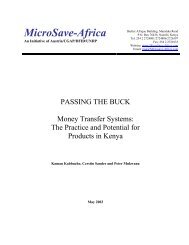You also want an ePaper? Increase the reach of your titles
YUMPU automatically turns print PDFs into web optimized ePapers that Google loves.
Photo source: Wikimedia Commons<br />
Promoting Agricultural Exports in Sri Lanka<br />
The $7.7 million Mahaweli Agriculture and Rural Development<br />
(MARD) Project in Sri Lanka, on which <strong>DAI</strong> served as<br />
a subcontractor to Oregon State University, was a landmark<br />
project <strong>of</strong> the 1980s. MARD was designed by Don Mickelwait<br />
to initiate agricultural production <strong>of</strong> the staple crop rice on<br />
one hand, and to promote diversification to more exportfriendly<br />
crops on the other. The project had a tough start.<br />
USAID rejected <strong>DAI</strong>’s first pick for Chief <strong>of</strong> Party, so Mickelwait<br />
persuaded Max Goldensohn to take the job. Goldensohn<br />
accepted and led a team <strong>of</strong> six “expats” and nine Sri<br />
Lankans in a project that would ultimately last eight <strong>years</strong>.<br />
Tea plantation near Kandy, Sri Lanka<br />
38<br />
A Bigger Ship<br />
While it was solving new development problems abroad, <strong>DAI</strong><br />
was also learning how to grow and prosper at home. In 1987,<br />
the company achieved its highest net income to date, on<br />
revenues <strong>of</strong> $12.7 million, and had <strong>40</strong> employees working on<br />
projects overseas in a dozen countries.<br />
As <strong>DAI</strong> doubled in size, computerization became a boon to<br />
management and staff. The 1980s were the “going digital”<br />
decade for most corporations, and the usual pattern was for<br />
computerization to begin in the back <strong>of</strong>fice and then eventually<br />
be applied to operations. But because Mickelwait was an<br />
early convert to personal computing, <strong>DAI</strong> computerized backward.<br />
It bought its first DEC word processor in 1981, a move<br />
fiercely resisted at first by its veteran production typist, who<br />
was wedded to his IBM Selectric. Other innovations soon<br />
followed. Mickelwait put an Ohio Scientific PC in an empty<br />
<strong>of</strong>fice and invited staff to try it out. By 1983, he had hired<br />
someone to install one <strong>of</strong> the first <strong>of</strong>fice-wide email systems<br />
on Televideo equipment, a hot item at that time, and by 1985,<br />
most <strong>DAI</strong> staff traveling overseas carried heavy 8-bit Kaypro<br />
PCs, which were the size and weight <strong>of</strong> a sewing machine.<br />
Carol Kulski, who arrived at <strong>DAI</strong> with the DEC word processor,<br />
accompanied one <strong>of</strong> Mickelwait’s consulting teams to<br />
Pakistan and produced the team’s report in the field, something<br />
the USAID mission had neither asked for nor expected.<br />
It was not until 1987, however, that the company installed the<br />
Deltek automated accounting system.<br />
As the company grew, the staff shared in the benefits. Individual<br />
stock ownership had been available to the most senior<br />
employees since the late 1970s, and the pr<strong>of</strong>it sharing retirement<br />
plan now held 30 percent <strong>of</strong> <strong>DAI</strong> shares, most <strong>of</strong> which<br />
had been contributed during 1981’s cash drought. It was not<br />
until the mid-1980s, however, that the Board <strong>of</strong> Directors de-



